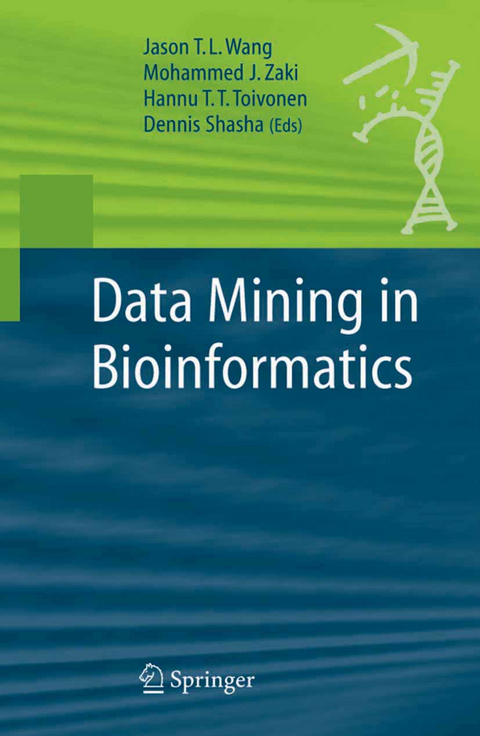
Data Mining in Bioinformatics
Seiten
2004
Springer London Ltd (Verlag)
978-1-85233-671-4 (ISBN)
Springer London Ltd (Verlag)
978-1-85233-671-4 (ISBN)
Protein subcellular location is important for understanding protein function inside the cell. The context of protein functionality is well represented by protein subcellular location.
8. 1. 1 Protein Subcellular Location The life sciences have entered the post-genome era where the focus of biologicalresearchhasshiftedfromgenomesequencestoproteinfunctionality. Withwhole-genomedraftsofmouseandhumaninhand,scientistsareputting more and more e?ort into obtaining information about the entire proteome in a given cell type. The properties of a protein include its amino acid sequences, its expression levels under various developmental stages and in di?erenttissues,its3Dstructureandactivesites,itsfunctionalandstructural binding partners, and its subcellular location. Protein subcellular location is important for understanding protein function inside the cell. For example, the observation that the product of a gene is localized in mitochondria will support the hypothesis that this protein or gene is involved in energy metabolism. Proteins localized in the cytoskeleton are probably involved in intracellular tra?cking and support. The context of protein functionality is well represented by protein subcellular location. Proteins have various subcellular location patterns [250]. One major category of proteins is synthesized on free ribosomes in the cytoplasm. Soluble proteins remain in the cytoplasm after their synthesis and function as small factories catalyzing cellular metabolites. Other proteins that have a target signal in their sequences are directed to their target organelle (such as mitochondria) via posttranslational transport through the organelle membrane. Nuclear proteins are transferred through pores on the nuclear envelope to the nucleus and mostly function as regulators. The second major category of proteins is synthesized on endoplasmic reticulum(ER)-associated ribosomes and passes through the reticuloendothelial system, consisting of the ERand the Golgi apparatus.
8. 1. 1 Protein Subcellular Location The life sciences have entered the post-genome era where the focus of biologicalresearchhasshiftedfromgenomesequencestoproteinfunctionality. Withwhole-genomedraftsofmouseandhumaninhand,scientistsareputting more and more e?ort into obtaining information about the entire proteome in a given cell type. The properties of a protein include its amino acid sequences, its expression levels under various developmental stages and in di?erenttissues,its3Dstructureandactivesites,itsfunctionalandstructural binding partners, and its subcellular location. Protein subcellular location is important for understanding protein function inside the cell. For example, the observation that the product of a gene is localized in mitochondria will support the hypothesis that this protein or gene is involved in energy metabolism. Proteins localized in the cytoskeleton are probably involved in intracellular tra?cking and support. The context of protein functionality is well represented by protein subcellular location. Proteins have various subcellular location patterns [250]. One major category of proteins is synthesized on free ribosomes in the cytoplasm. Soluble proteins remain in the cytoplasm after their synthesis and function as small factories catalyzing cellular metabolites. Other proteins that have a target signal in their sequences are directed to their target organelle (such as mitochondria) via posttranslational transport through the organelle membrane. Nuclear proteins are transferred through pores on the nuclear envelope to the nucleus and mostly function as regulators. The second major category of proteins is synthesized on endoplasmic reticulum(ER)-associated ribosomes and passes through the reticuloendothelial system, consisting of the ERand the Golgi apparatus.
Overview.- to Data Mining in Bioinformatics.- Survey of Biodata Analysis from a Data Mining Perspective.- Sequence and Structure Alignment.- AntiClustAl: Multiple Sequence Alignment by Antipole Clustering.- RNA Structure Comparison and Alignment.- Biological Data Mining.- Piecewise Constant Modeling of Sequential Data Using Reversible Jump Markov Chain Monte Carlo.- Gene Mapping by Pattern Discovery.- Predicting Protein Folding Pathways.- Data Mining Methods for a Systematics of Protein Subcellular Location.- Mining Chemical Compounds.- Biological Data Management.- Phyloinformatics: Toward a Phylogenetic Database.- Declarative and Efficient Querying on Protein Secondary Structures.- Scalable Index Structures for Biological Data.
| Erscheint lt. Verlag | 18.10.2004 |
|---|---|
| Reihe/Serie | Advanced Information and Knowledge Processing |
| Zusatzinfo | 110 Illustrations, black and white; XII, 340 p. 110 illus. |
| Verlagsort | England |
| Sprache | englisch |
| Maße | 155 x 235 mm |
| Themenwelt | Mathematik / Informatik ► Informatik ► Datenbanken |
| Mathematik / Informatik ► Informatik ► Theorie / Studium | |
| ISBN-10 | 1-85233-671-4 / 1852336714 |
| ISBN-13 | 978-1-85233-671-4 / 9781852336714 |
| Zustand | Neuware |
| Informationen gemäß Produktsicherheitsverordnung (GPSR) | |
| Haben Sie eine Frage zum Produkt? |
Mehr entdecken
aus dem Bereich
aus dem Bereich


